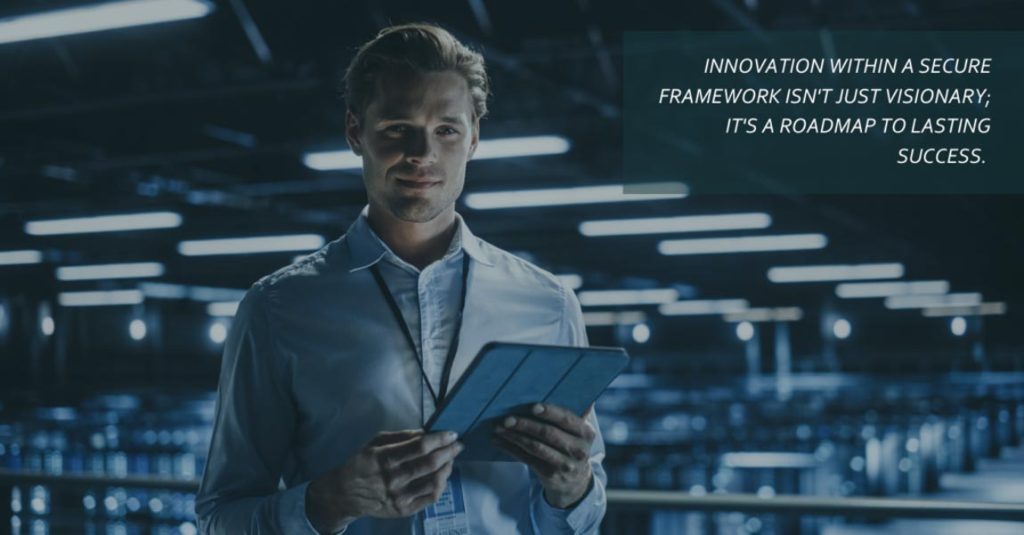Navigating the Complex Threat Landscape of Cybersecurity in an Era of Innovation

Imagine, a dynamic tech company on the cusp of a groundbreaking IoT device launch. Amidst excitement and innovation, they experience a cyberattack exploiting a vulnerability in their device’s firmware. Chaos ensues as lights flicker; thermostats malfunction and security cameras go rogue due to unauthorized access. The fallout overshadows the company’s visionary innovation.
This is the reality for thousands of businesses a year, but it doesn’t have to be. In a world where innovation drives success, the intersection of technology and security is more critical than ever. With the evolving threat landscape, it’s imperative to take action to safeguard your organization’s future.
In this blog post, we take a look at how you can safeguard your business with security without stifling innovation.
Key Summary
- Successful businesses integrate innovation with robust cybersecurity measures to achieve lasting success and a competitive edge.
- Cyber threats are advancing, employing cutting-edge techniques like AI and malware, necessitating proactive security strategies.
- Phishing and social engineering persist as effective tactics, highlighting the need for ongoing employee security training.
- Mitigating risks involves addressing vulnerabilities in the supply chain and managing both unintentional and malicious insider threats.
- Framing security as a bridge between innovation and success strengthens the organization’s resilience and cultivates a culture of innovation.
- A comprehensive security approach includes risk assessment, employee training, MFA, threat intelligence, and regular penetration testing.
- Effectively communicating cybersecurity strategies is crucial to ensuring organizational security and success in an ever-changing digital landscape.
Understanding the Evolving Threat Landscape
The realm of cyber threats is intricate, but let’s break it down. Imagine it as a chess game, with threat actors making calculated moves. They’ve grown more sophisticated, targeting vulnerabilities with precision. The once simplistic and sporadic attacks of pawns have given way to a new breed of adversaries wielding more sophisticated and persistent cyber threats.

Attackers now leverage cutting-edge techniques such as advanced malware, artificial intelligence, and machine learning to craft attacks that are increasingly difficult to detect and mitigate. These techniques allow attackers to adapt to defences, evade traditional security measures, and exploit vulnerabilities with alarming precision.
As major cybersecurity threats continue to evolve, certain trends are clear:
- Phishing and Social Engineering: Despite technological advancements, humans remain the weakest link in the security chain. Social engineering attacks, such as phishing and spear-phishing, continue to successfully deceive individuals into divulging sensitive information.
- Ransomware: The rise of ransomware-as-a-service (RaaS) has democratized cyber extortion, leading to a surge in attacks against businesses, government agencies, and critical infrastructure.
- Supply Chain Attacks: Attackers have honed their focus on the weakest link in the chain, leading to supply chain attacks that compromise trusted vendors to infiltrate customers’ systems. The SolarWinds and Kaseya incidents exemplify these breaches of trust.
- Insider Threats: Both unintentional and malicious insider threats pose substantial risks, emphasizing the need for comprehensive security training and robust access controls.
Balancing Innovation and Security
The interplay between innovation and security is a familiar challenge. While innovation drives growth and keeps your organization ahead, it’s crucial to acknowledge that it can also introduce vulnerabilities. Imagine this scenario: a company rushes an innovative app to market to gain a competitive edge. However, bypassing thorough security assessments leads to a data breach, resulting in fines, legal entanglements, and a loss of customer trust.
This is more common than you would think. For the average business, cyberattacks take months, yes months, to detect.
A successful business strategy integrates groundbreaking innovation with a commitment to cybersecurity. So what can you do?
- Adopt a Security-First Mindset: Integrate security from the outset of innovation initiatives. Involve cybersecurity experts early on to identify potential risks and devise protective measures.
- Enlist Continuous Assessment: Regularly evaluate the security of innovations throughout their lifecycle. Conduct vulnerability testing, code reviews, and security audits to address potential weaknesses.
- Implement Employee Training: Educate your team on security’s importance and their role in upholding it. Empower them to recognize and report security vulnerabilities with Security Awareness Training.
- Establish a Collaborative Culture: Foster collaboration between innovation and security teams. Open communication ensures innovations are both cutting-edge and robust.
- Leverage Agile Security: Embrace agile security practices for swift adaptation to new threats and changes such as Difenda MXDR.
Innovation within a secure framework isn’t just visionary; it’s a roadmap to lasting success.
The Cost of Inaction
Let’s explore the real-world consequences of overlooking proactive security measures. Take Company A, a trailblazer in its field, launching an innovative product without adequate cyber safeguards. A subsequent data breach exposed customer data, eroding trust, lowering sales, and plummeting stock prices.
Similarly, Company B’s rush into technological advancement without addressing vulnerabilities led to a ransomware attack, halting operations, causing revenue loss, and straining client relationships.
These stories underscore inaction’s weight against cybersecurity threats. Risks encompass more than finances—trust erosion, reputation damage, and legal repercussions. Imagine operational disruption due to a breach; its impact on loyalty and market standing could be overwhelming.
The truth: risks are too grave to ignore. It’s predicted that cybercrime cost the global economy around $7 trillion in 2022, and this number is expected to rise to $10.5 trillion by 2025. Innovation drives growth, yet neglecting security undermines your foundation. Proactive security isn’t a barrier but an investment in sustainability.
Navigating this complexity involves seamlessly integrating security into innovation strategies. Proactively spotting vulnerabilities, enforcing robust measures, and fostering a vigilant culture bolster defences. Addressing risks head-on safeguards investments sustains trust, and ensures resilience in an interconnected digital realm. The stakes are high, but the way forward is clear—proactive action secures your future.
Strategic Alignment
In the intricate dance between innovation and security, the synergy between these two seemingly divergent forces is a source of immense opportunity. Framing security discussions within the context of your business objectives and goals can unleash a new realm of possibilities, enhancing not only your organization’s resilience but also its competitive edge.
Imagine security not as a barrier, but as a bridge—one that spans the divide between innovation and success. By aligning security measures with your business objectives, you establish a fortified foundation for innovative endeavors. Rather than stifling progress, this approach creates a dynamic environment where innovation thrives securely.

Practical Steps for Immediate Action
Understanding the urgency of securing your organization against evolving threats, let’s delve into practical steps that align with actionable solutions. This 5-point concise checklist equips security leadership with a clear path to enhance your organization’s security posture:
- Risk Assessment: Initiate a comprehensive risk assessment to identify potential vulnerabilities across your digital landscape. Evaluate critical assets, data flows, and potential threat vectors. This assessment serves as the foundation for your security strategy.
- Employee Security Awareness Training: Bolster your first line of defence—your workforce. Implement comprehensive Security Awareness Training programs to educate employees about the latest threats, phishing tactics, and best practices for data protection.
- Multi-Factor Authentication (MFA): Enforce MFA for accessing critical systems and sensitive data. This extra layer of security significantly reduces the risk of unauthorized access, even in the event of compromised credentials.
- Threat Intelligence: Stay updated with the latest threat intelligence to anticipate potential attacks. Leverage threat intelligence platforms and services to monitor emerging threats that could impact your organization like Difenda’s Threat Advisories.
- Penetration Testing: Engage ethical hackers to perform regular penetration testing to identify weaknesses in your systems before malicious actors can exploit them.
By framing security as an enabler of innovation, you’re not only bolstering defences but also cultivating a culture of resilience. This alignment elevates your organization, propelling you towards uncharted horizons with the wind of innovation at your back.
Read our 10-point cybersecurity program checklist.
The evolution of the cyber threat landscape, marked by sophisticated and persistent adversaries, demands that organizations approach security with a renewed sense of urgency. As technology continues to reshape the world around us, the delicate interplay between innovation and security becomes paramount.
By striking the right balance between innovation and security, organizations can confidently explore new horizons, knowing they are fortified against the ever-present threat of cyber-attacks.
Ready to Dive Deeper? Download Our eBook!


